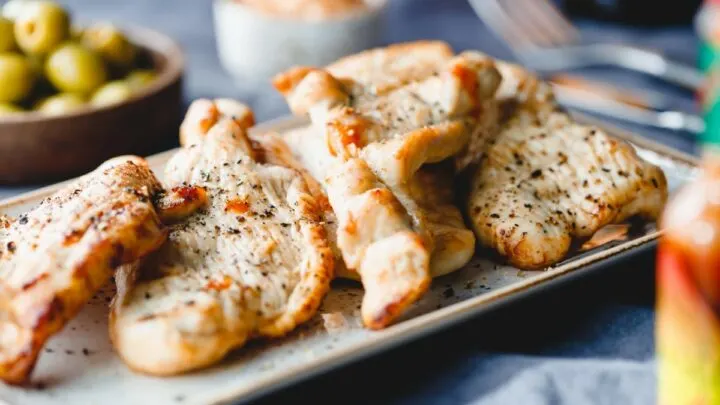Cooking is more than just preparing and cooking food. It also involves many other processes, such as taking safety precautions such as cooking the meat thoroughly.
Meat needs to be cooked to its correct internal temperature because if it is not, then this puts your health at risk.
You can keep an eye on this by checking the internal temperature of the food. One food people may check the internal temperature of is turkey.
In this article, we will go into what the internal temperature of the turkey is, how to check it, the risks of eating undercooked meat, and finally, how to safely cook it.
Contents
What Is a Turkey’s Internal Temperature?
If you are checking the internal temperature of meat, you are using a meat thermometer to check the inner temperature of the meat.
The required internal temperature depends on the kind of meat in question.
Red meat, which comes from a four-legged animal and is red in its raw form, needs to be around 145 degrees Fahrenheit.
Poultry, on the other hand, needs to be cooked to an internal temperature of 165 degrees Fahrenheit. Turkey is a bird, so this falls into the category of poultry.
How Do You Check a Turkey’s Temperature?
Turkey, much like chicken, needs to be cooked to an internal temperature of 165 degrees Fahrenheit to be considered safe enough for you to consume. You can check this by using a meat thermometer. To use this, you must:
- After the turkey is done cooking, you need to let it sit for at least three minutes.This is called rest time, and you let it rest because you want the temperature read to be accurate.
- Once the three minutes are up, grab whatever meat thermometer you have and place it inside the meat. Also, make sure it is not touching bone or fat so you can get a proper read.
- If the thermometer reads the correct temperature, take out the thermometer and wash it thoroughly.
By following these steps, you will be able to ensure your turkey has been thoroughly cooked through.
If you do not happen to have a meat thermometer on hand, it’s very easy to get your hands on one. They are very affordable, so just shop around either at stores or online.
What Happens if You Eat Undercooked Turkey?
It’s important that you don’t eat undercooked turkey because if you do, you are putting yourself at risk of getting ill from the bacteria that can lurk inside the turkey.
Eating undercooked turkey can cause the following illnesses.
- A well-known bacteria called Salmonella lives inside birds. If you end up with salmonella, you can get diarrhea, nausea/vomiting, cramps, and headache, to name a few common symptoms. For most people, it will go away on its own, but sometimes it does require medical treatment. This usually involves having severe enough diarrhea that just won’t go away or stop.
- Clostridium perfringens is a common bacteria that cause food poisoning. Most of the time, food poisoning isn’t fatal. If you have food poisoning, you’ll end up with symptoms like diarrhea and stomach cramps. Usually, the symptoms show up within 24 hours or less and will go away on their own. Now if they don’t or get more severe, then you do need to seek medical treatment.
- Campylobacter is another bacteria that lives inside turkeys and other birds. If you get this illness, you will get diarrhea, stomach cramps, vomiting/nausea, and fever. Most of the time, this illness will go away on its own, but for people like the elderly, children, and those with compromised immune systems, it can be very serious.
The best way to prevent these diseases is by cooking the turkey thoroughly. Trust us when we say that you don’t ever want to experience getting sick with any of these bacteria!
Ways to Safely Cook a Turkey
There are several ways to cook a turkey, and we’ve narrowed down some of the more popular ways to do so. These include:
- One way to cook a turkey is by using a slower cooker. Now you need to have a slow cooker on hand. If you are going to use this method. After seasoning your turkey and putting it inside the slow cooker, turn it on low and cook it for about 8 to 9 hours. The best way about using this method is that you can just quickly do it in the morning, and by the time you get home from work, it will be ready! You can also cook it in an instant pot which is similar to a slower cooker.
- If you have an air fryer on hand, you’ll be able to use it for cooking a turkey that is on the small side. After seasoning, put the turkey in the air fryer and fry at 390 degrees for about 30 to 35 minutes. Again, this only works if you have an air fryer on hand, much like the slow cooker method.
- Finally, one of the more popular methods of cooking turkey is by using an oven. Preheat the oven to 350 degrees, and then place the turkey in a roasting pan after you prepare it in whatever way you prefer. Once it’s in the oven, cook it for 2 to 2 and a half hours.
Not everyone has a slow cooker or air fryer, so the oven method is going to be the default one.
Final Thoughts
And there you go, all you turkey lovers out there! Now you know exactly what the internal temperature of the turkey is, how to check for it, the risks of eating undercooked chicken, and finally, ways to cook it properly.
If you are unused to using a meat thermometer, do not worry because it is very easy to use one.
By following our simple instructions, you will be able to use it in no time. Then, after you have used it again and again, it will become like second nature to you.
You might also be interested in the following:
- What Is the Right Internal Temperature of Swordfish?
- What Is the Right Internal Temperature of Lamb?
- What Is the Right Internal Temperature of a Lobster Tail?
- What Is the Right Internal Temperature of Steak?
- What Is the Right Internal Temperature of Salmon?
- What Is the Right Internal Temperature of Chicken?
- What Is the Right Internal Temperature of Duck?
- What Is the Right Internal Temperature of Meatloaf?
- What Is the Right Internal Temperature of Pork?
- What Is the Right Internal Temperature of Cooked Fish?

I have been smoking and grilling meat from an early age and enjoy sharing my knowledge and expertise through the hundreds of articles I have written about BBQ. I hope to make everyone’s BBQ journey that little bit easier.

